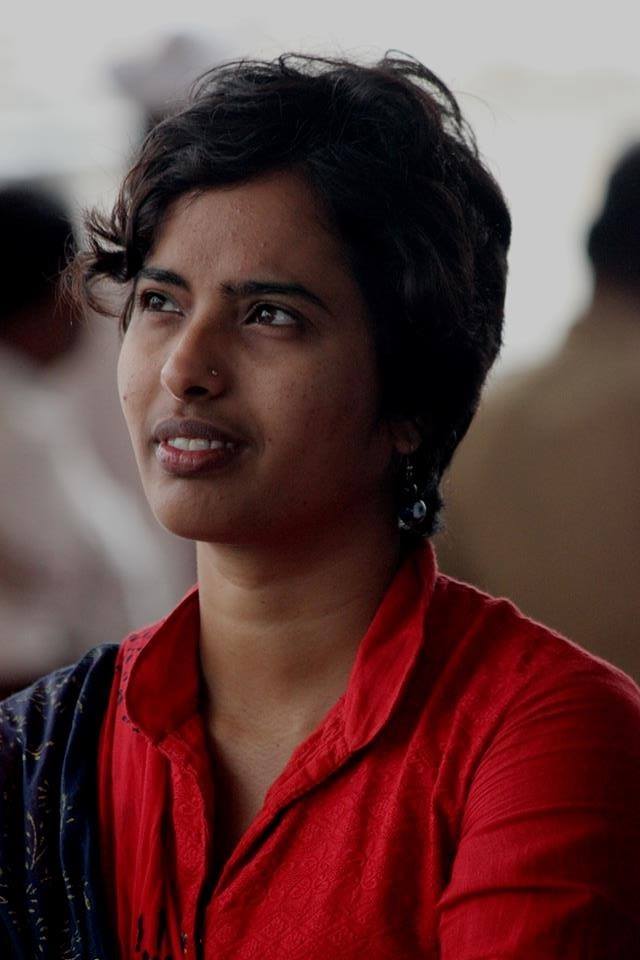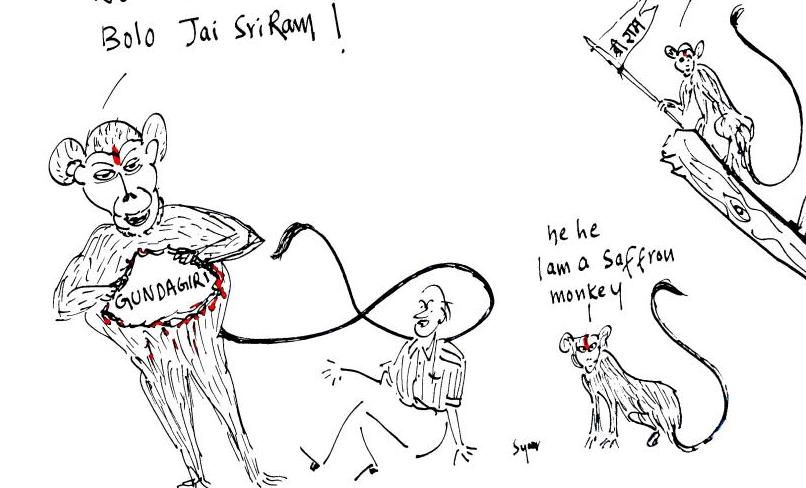Kanika Sori
In February this year, a young Savarna woman from Srishti School of Art Design and Technology, Bangalore, created a photo-project that went viral. It was hosted by fifty different kinds of media portals. Recently it was recycled by an e-zine called Storypick for public consumption. Its creator called the album ‘Perspectives,’ and it was meant to be an assignment submission for a course she was taking. Her college happens to attract the most elite of the Brahmin-savarnas from all over the country as both teachers and students. So, these expressed ‘perspectives’ of fear and safety in the public spaces come from the Savarna women’s gaze, with the vast majority of working castes being used both as the canvas and the drawn monster.

In the photo-project, the female protagonist seems to have left the ‘safety’ of her modern house in one of the exclusively upper-caste colonies to step into an ‘unsafe’ open neighborhood with differently dressed unsuspecting Bahujans going about their daily business. Her friend clicks her photographs as she poses deceptively with them in the frame. An outlandish activity for these other people in an otherwise uneventful day of usual, ungrateful labour for a meagre living. This was a local street bazaar that can be seen hosting very small shops and stalls, the kind which are not frequented by Savarna women unlike, say, Khan Market or Brigade Road. Her bizarre placement in their everyday work scenes evoked expressions of shock and curiosity, as it would have in any Savarna ‘middle-class’ person who might have been there, simply because these aren’t the caste locations for Savarna socializing. These expressions are then captured on camera and published without consent. This exercise is projected as the ‘difficulties of being a girl’ in the streets.
A Savarna woman’s imagery becomes a public canvas upon which modernity, traditionalism and protectionist discourse is balanced. A typical college-going savarna is born in a home in a private colony, grows up in the safety of a personal room, goes to expensive schools catering exclusively to their class, shops in exclusive malls, and has a social circle that draws exclusively from the same ruling class. Segregated from supposedly virile and threatening masculinity of lower caste/class ‘others,’ it is in these kinds of bubble-like spaces that any middle-class woman feels absolved from the fear of violence that “stalks” the city space. Needless to say, the landscape of the site of this project doesn’t feature in these places.
Gramsci (1971) believes that the social production of space is commanded by those in power – the hegemonic class – as a tool to reproduce their dominance.[1] As does the Indian ruling class as it seeks to engineer the streets to accommodate the Varnashram prescribed social relations by projecting its womenfolk at constant risk from the eyes and touch of the traditionally lower castes. The stereotype once successfully manufactured, and propagated until it becomes commonsense, can come handy to put down these obviously ‘misogynist, criminal’ people in their place, which can sometimes be in jails. As Yogesh Maitreya points out, many people from marginalized sections find themselves rotting in the confinement of prisons on minor pretexts, sometimes just on the basis of some doubt.[2] Such Brahmin-enabled feminist projects can therefore be seen as a form of racialized social control using the process of criminalization to find new ways to enable ostracization, incarceration and other forms of caste-motivated social controls.
In her analysis of Golf Links, an upscale colony near Khan Market in New Delhi, Anne Waldrop (2004) argues that the phenomenon of fortifications marks a response to the shaking material interests of the ruling castes (class) under economic liberalization, and is an attempt to re-establish a sense of order.[3] Situational change brings uncertainty. Through such gated communities the delicate dreams of many are maintained through anxious Savarna class exclusivity. These places are lived in ways that are far removed from the perceived source of sexual danger: Bahujan men. Segregated savarna spaces are seen as modern, safe and empowering for Savarna women precisely because dalit-bahujans have no access. It is here that Savarna women engage in what might be perceived as sexualized presentations of self – swimming in a private pool, jogging through condominium grounds, dancing together with men on an outdoor stage at corporate-sponsored Holi.[4]
Through such restrained freedom of choice, women are given the possibility of maintaining their reputation while taking part in activities they might usually be denied by their families. And simultaneously participate in the narrative of casteist-patriarchal protection, purity and caste conservatism.
Economic liberalization (1991) has brought about a contrasted duality wherein women are seen as both sexually empowered and liberated, whilst also retaining their investment in caste preservation. This requires of Savarna women to ignore and/or cover up masculinist protection and conservatism doled out by their family men and women by way of safety discourses, like the one suggested by the photo-project. In return, while inhabiting other movements, their families enable certain privileges – securing a job in the private sector, driving a private car, wear western clothes etc.
As Anu Ramdas (2017) puts it: Privileges can be lost, taken away, withdrawn or withheld as they are not rights. Therefore, these privileges are just as easily revocable within these families as a woman gets married, births a child, or loves someone outside of her caste, etc. In this way savarna women have an acceptable form of ‘agency’ flavored by consumerist freedoms, like the choice of wearing a short skirt which the Storypick article foolishly alleges to be threatened by the working-class gaze.
But this victimhood is not to be perceived as a non-agentive state of being, above and beyond politics. Within this regulated social structure, savarna women have the tools and resources to work the system to their advantage.[5] Consumer culture is essentially materialistic: it is about the concrete, the material, the here and now of possession.
Bourdieu (1984) identifies ways of dressing as manifestations of the identity, as a marker of class distinction.[6] In India too, as in other parts of the world, a woman’s (and man’s) appearance is sought to be seen as a reflection of her social class background.[7][8] But fashions diffuse down the social hierarchies as they are continuously adopted and abandoned by the social elites, as ‘lower’ groups take up the style.[9] That is, while the exclusivity of the savarna class in schools, colleges, jobs, and in, our case, dressing codes (a right historically denied [10]) was being eroded; they moved to this hyper designer trends enabled by globalization. This seemingly innocent ‘choice’ of modern western dressing should be seen as an attempt to differentiate and construct an identity beyond the fading traditional elite Indian, above the affairs of Indian-ness of the Bahujan women clad in sarees in the photo-project. Savarna women aspirations throw the full force of their capital behind constructing these new images and trends, by contrasting themselves against this new image of Bahujan “conservative,” a byproduct of this exercise.
Thus, such consumerist “choices” instead of existing in a vacuum give the dominant class the means of maintaining and reproducing supremacy. Through such visible markers the Savarna women can at once paint the ‘backward minded others’ as threats to her ways of life, and yet claim stakes in the ruling class powers from their fellow men. This extends the fake project of elite women – White women and Indian brahmin feminist – that says patriarchal violence and threat is external to their savarna world, against the rationale of global factual data indicating women are under maximum threat from intimate relations within their own class. At the end, the Bahujan is left policing its own class in morality and manners, reaping from it no material gains today or tomorrow.
~
References:
1. Gramsci, A. 1971. Selections From the Prison Notebooks of Antonio Gramsci. ed. Hoare, Q; Nowell – Smith, G. New York: International Publishers
2. Yogesh Maitreya, 2015. A critique of ‘Court’ and the Brahmin Agency Behind it. http://roundtableindia.co.in/index.php?option=com_content&view=article&id=8180:a-critique-of-court-and-the-brahmin-agency-behind-it&catid=119&Itemid=132
3. Waldrop, A. 2004. ‘Gating and Class Relations: the case of a New Delhi “colony”’, City & Society16(2): 93-116.
4. Gilbertson, A. 2014. ‘A Fine Balance: Negotiating fashion and respectable femininity in middle – class Hyderabad, India’, Modern Asian Studies 48(1) : 120 – 158
5. Women and Community, Jenny Rowena; http://www.dalitweb.org/?p=2828
6. Bourdieu, Pierre (1984), Distinction: A Social Critique of the Judgment of Taste. Cambridge, MA: Harvard University Press
7. Akhil Kang, Ambedkar helped me embrace the ‘emotional’ within the rational. https://roundtableindia.co.in/index.php?option=com_content&view=article&id=8200:ambedkar-helped-me-challenge-oppression-and-embrace-the-emotional-within-the-rational&catid=119:feature&Itemid=132
8. Christina T. Dhanraj, Who’s your perfect Dalit Woman? https://roundtableindia.co.in/index.php?option=com_content&view=article&id=8811:who-s-your-perfect-dalit-woman&catid=119:feature&Itemid=132
9. Simmel, G (1904/ 1971) ‘Fashion’, On Individuality and Social Forms: Selected Writings, trs D.C.Levine, Chicago: University of Chicago Press
10. James Michael, Yesudas and I: Many Hues of a Prejudice. https://roundtableindia.co.in/index.php?option=com_content&view=article&id=7701:yesudas-and-i-many-hues-of-a-prejudice&catid=119:feature&Itemid=132
~~~
Kanika S is a biotech engineer from IIT Roorkee and currently based in Delhi.
Illustration by Syam Cartoonist










